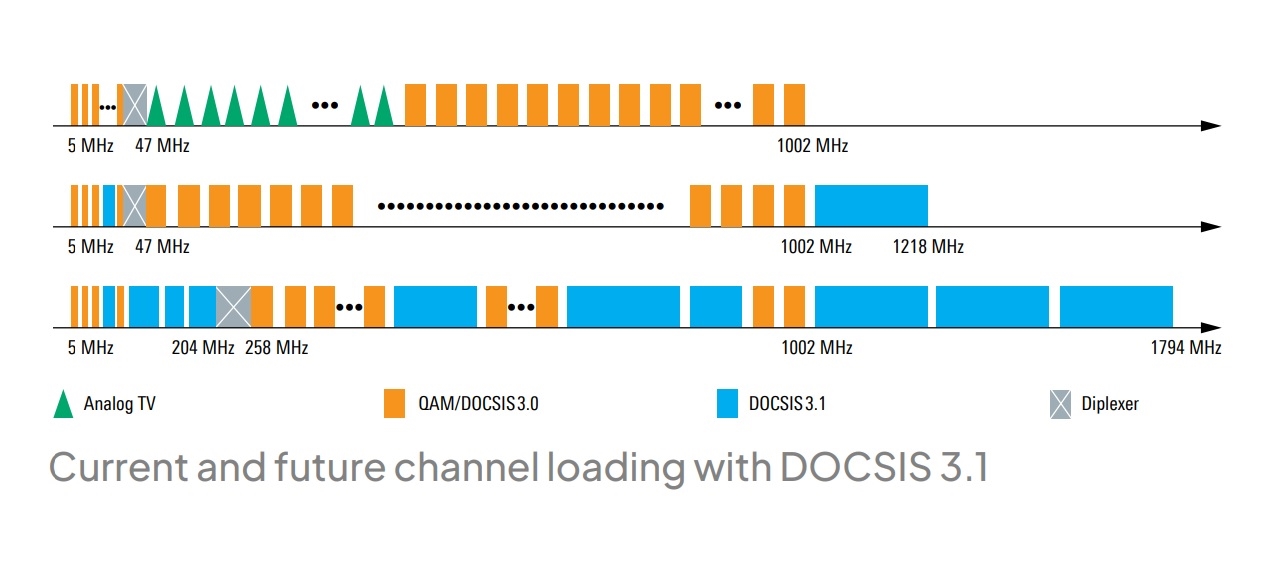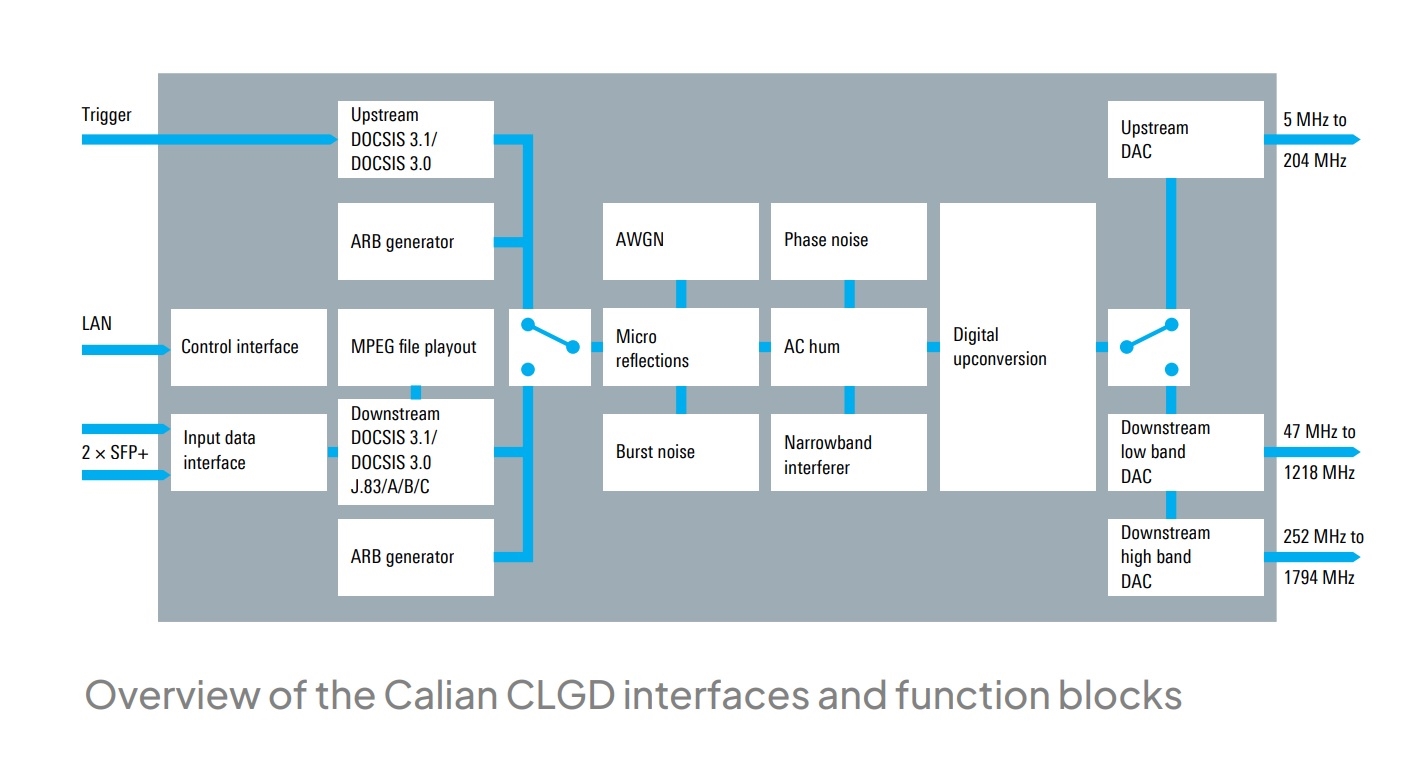- PRODUCTS代理廠牌
產品明細
CLGDDOCSIS全頻道負載信號產生器
產品簡述
♦ 支援DOCSIS 3.1/3.0, J.83/A/B/C 及類比 TV信號
♦ 支援Downstream: 47 MHz to 1218 MHz/1794 MHz, Upstream: 5 MHz to 204 MHz
♦ 支援FDX – Full duplex DOCSIS 4.0 generator
♦ 提供最多8個DOCSIS 3.1 downstream 192 MHz signal bandwidth
♦ 支援任意波形產生器(ARB generator) bandwidth up to 200 MHz
♦ 支援全頻段AWGN輸出
♦ 支援信號干擾與失真模擬
產品詳細介紹Product Introduction
Calian CLGD DOCSIS Cable Load Generator
Multichannel signal generator for DOCSIS 3.1 downstream and upstream
The Calian CLGD is a multichannel signal generator for simulating a cable TV network with full channel loading. It generates broadband data signals for DOCSIS 3.1 as well as digital and analog TV channels. In the downstream or upstream, signals can be freely combined, allowing users to simulate any conceivable channel loading scenario in the lab.
The Calian CLGD is the first generator that simultaneously produces signals for DOCSIS 3.1, DOCSIS 3.0, digital cable TV in line with J.83/A/B/C and analog cable TV. Its downstream frequency range is 108 MHz to 1794 MHz for DOCSIS 3.1 and 47 MHz to 1218 MHz for TV. Within this range, the Calian CLGD generates multiple DOCSIS 3.1 channels with up to 192 MHz bandwidth each. The level, frequency, forward error correction (FEC) and constellation of these channels can be set independently. At the same time, the Calian CLGD produces a large number of digital and analog TV signals that can be placed anywhere below or between the DOCSIS 3.1 signals. The DOCSIS 3.1 channels and digital TV channels are implemented in realtime. The data to be transmitted can be fed in via IP or internally generated by the Calian CLGD. The upstream frequency range is 5 MHz to 204 MHz. Within this range, DOCSIS 3.1 orthogonal frequency division multiple access (OFDMA) signals can be freely combined with DOCSIS 3.0 TDMA or CDMA signals.
The flexible multichannel signal generation capabilities of the Calian CLGD enable it to simulate network loading in a reproducible manner, making it ideal for testing tuners, cable modems and upstream CMTS receivers. The influence of QAM and TDMA/CDMA signals in adjacent channels on DOCSIS 3.1 signal reception is a research topic of great interest. The Calian CLGD makes such simulations realistic by adding different types of interference, such as noise, reflections and narrowband interference. The generator is accommodated in a 19” housing that takes up a mere two height units. The complex signal generation process can be conveniently controlled from a PC or via a web interface. Remote control through SCPI commands enables the generator to be used in automatic test systems. The Calian CLGD can be adapted to various application requirements thanks to its software option concept.
Features- Frequency range in downstream: 47 MHz to 1218 MHz, extendable to 1794 MHz
- Frequency range in upstream: 5 MHz to 204 MHz
- DOCSIS 3.1, DOCSIS 3.0, J.83/A/B/C and analog TV
- Up to eight times 192 MHz signal bandwidth for DOCSIS 3.1
- ARB generator bandwidth up to 200 MHz
- Signal generation for channel loading scenarios in the downstream
- Realtime modulation of DOCSIS 3.1 and J.83/A/B/C
- Combined load simulation of DOCSIS 3.1, digital and analog TV
- Cable modem data traffic simulation in the upstream
- Any combination of OFDMA, TDMA and CDMA signals
- Trigger function for burst timing control
- Signal interference and distortion simulation
- Noise, impulsive noise and phase noise
- Microreflections
- AC hum
- Uptilt and downtilt
- Ingress simulation with superimposed interference signals

Application- Signal generation for channel loading scenarios in the downstream
- Realtime modulation of DOCSIS 3.1 and J.83/A/B/C
The Calian CLGD features an FPGA-based multichannel modulator for broadband data transmission with DOCSIS 3.1 and for digital cable TV in line with ITU-T J.83/A/B/C. The modulator generates signals with decodable content in realtime – just like CMTS and headend modulators. Frequency, level and modulation parameters can be set as required.
- The following parameters are relevant for DOCSIS 3.1:
- FFT size or number of OFDM carriers: 4k or 8k
- Interleaver depth
- Profile constellation: 16QAM to 16384QAM
- NCP constellation: QPSK to 64QAM
- PLC location
- Cyclic prefix and windowing
- Exclusion band: unused OFDM carriers
- Continuous pilot parameter
The Calian CLGD DOCSIS 3.1 channels transmit internally generated PRBS or data streams fed in via IP. The Calian CLGD generates digital cable TV signals in line with J.83/A (DVB-C), J.83/B and J.83/C (ISDB-C). Users can set frequency, level, symbol rate, interleaver depth and constellation as required. The digital TV channels in the Calian CLGD contain PRBS or MPEG-2 transport streams that are either fed in via IP or internally generated from a file.
- Combined load simulation of DOCSIS 3.1, digital and analog TV
The Calian CLGD is primarily intended for simulating cable TV networks with full channel loading. Its downstream frequency range is 47 MHz to 1218 MHz (optionally expandable to 1794 MHz). The Calian CLGD generates several DOCSIS 3.1 channels as well as digital and analog TV channels. The following combinations are possible:
• Up to 8 DOCSIS 3.1 channels
• Up to 4 DOCSIS 3.1 channels and up to 160 TV channels
The Calian CLGD is ideal for examining the mutual influence between DOCSIS 3.1 and J.83/A/B/C to ensure the coexistence of new broadband data services and conventional TV transmissions. The Calian CLGD ARB generators add additional signals, such as user-defined signals or the FM sound broadcasting band that is fed into the cable in some countrie

- Cable modem data traffic simulation in the upstream
- Any combination of OFDMA, TDMA and CDMA signals
The upstream spectrum that arrives at the CMTS receiver consists of transmissions from many individual cable modems. The Calian CLGD generates this spectrum in the frequency range from 5 MHz to 204 MHz with a maximum of two DOCSIS 3.1 OFDMA channels and up to 32 DOCSIS 3.0 channels with TDMA or CDMA, effectively simulating the data traffic from a large number of cable modems. TDMA and CDMA signals always contain data packets. DOCSIS 3.1 signals contain different message types (see table). The Calian CLGD ARB generators can also add user-defined signals in the upstream.
- Trigger function for burst timing control
Cable modems transmit short, time-limited data packets (bursts). If there is a sufficiently high number of modems in the network, the individual bursts are superimposed to generate an almost continuous signal. For DOCSIS 3.1, the result is an OFDM signal in which different modems occupy different parts of the subcarrier. For DOCSIS 3.0 TDMA, the result is a pulsed signal with individual bursts from different modems. For use as a load generator, the Calian CLGD generates exactly the type of signals needed to simulate the data traffic sum of multiple modems. The Calian CLGD can also generate individual bursts in a single channel. The burst timing is controlled by the trigger function, making it possible to simulate modem ranging when registering with a CMTS.
- Signal types in the upstream
- Signal interference and distortion simulation
The Calian CLGD can add interference to the output signal to simulate realistic receive conditions, making it ideal for testing cable modems, amplifiers and upstream CMTS receivers.
- Noise, impulsive noise and phase noise
Additive white Gaussian noise (AWGN) is mainly caused by line amplifier noise and cable loss. Electromagnetic interference from household appliances, motors and light switches cause impulsive noise. Phase noise is generated by oscillators in the CMTS. The Calian CLGD can superimpose these types of noise on the wanted signal (separately or concurrently).
Connectors, bends and minor damage in the cable can cause microreflections that result in echoes in the wanted signal. These reflections are negligible, but in sum they may disturb reception. The Calian CLGD simulates up to five reflections with settable strength and duration.
Aging of components in line amplifiers can lead to 50 Hz/60 Hz AC hum in the cable, resulting in superimposed amplitude modulation. The Calian CLGD allows users to modulate its entire output spectrum with settable frequency and modulation depth.
Higher frequencies lead to higher cable loss. This is why the spectrum that arrives at the viewer’s outlet is more or less downtilted. This effect is partially compensated by an uptilt spectrum output by the line amplifiers. Using analog highpass and lowpass filters, the Calian CLGD can simulate both uptilt and downtilt with settable tilt angle. The signalto-noise ratio remains constant in the entire frequency range. There is even a tilt within the channels.
- Ingress simulation with superimposed interference signals
The expansion of cable TV networks into higher frequency ranges and the use of the former UHF TV band for mobile services increasingly lead to ingress interference in the cable. The upstream is also vulnerable to ingress since the same frequency range is shared by a large number of services. The Calian CLGD can superimpose an interference signal on the wanted signal. The level and bandwidth are settable. This feature makes it possible to analyze the influence of LTE ingress on the reception quality of a DOCSIS 3.1 channel.